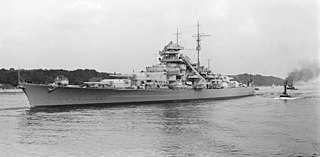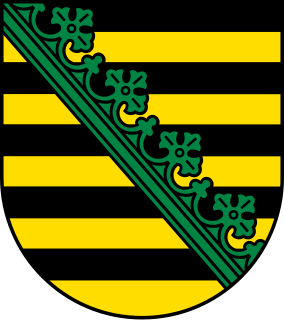Related Research Articles

The Imperial German Navy was the navy created at the time of the formation of the German Empire. It existed between 1871 and 1919, growing out of the small Prussian Navy, which primarily had the mission of coastal defence. Kaiser Wilhelm II greatly expanded the navy, and enlarged its mission. The key leader was Admiral Alfred von Tirpitz, who greatly expanded the size and quality of the navy, while adopting the sea power theories of American strategist Alfred Thayer Mahan. The result was a naval arms race with Britain as the German navy grew to become one of the greatest maritime forces in the world, second only to the Royal Navy. The German surface navy proved ineffective during World War I; its only major engagement, the Battle of Jutland, was indecisive. However, the submarine fleet was greatly expanded and posed a major threat to the British supply system. The Imperial Navy's main ships were turned over to the Allies, but were scuttled at Scapa Flow in 1919 by German crews.

Year 1119 (MCXIX) was a common year starting on Wednesday of the Julian calendar.

Bismarck was the first of two Bismarck-class battleships built for Nazi Germany's Kriegsmarine. Named after Chancellor Otto von Bismarck, the ship was laid down at the Blohm & Voss shipyard in Hamburg in July 1936 and launched in February 1939. Work was completed in August 1940, when she was commissioned into the German fleet. Bismarck and her sister ship Tirpitz were the largest battleships ever built by Germany, and two of the largest built by any European power.

The House of Wettin is a dynasty of German counts, dukes, prince-electors and kings that once ruled territories in the present-day German states of Saxony, Saxony-Anhalt and Thuringia. The dynasty is one of the oldest in Europe, and its origins can be traced back to the town of Wettin, Saxony-Anhalt. The Wettins gradually rose to power within the Holy Roman Empire. Members of the family became the rulers of several medieval states, starting with the Saxon Eastern March in 1030. Other states they gained were Meissen in 1089, Thuringia in 1263, and Saxony in 1423. These areas cover large parts of Central Germany as a cultural area of Germany.

The Bishop of Dresden-Meissen is the ordinary of the Roman Catholic Diocese of Dresden-Meissen in the Archdiocese of Berlin.

Meissen porcelain or Meissen china was the first European hard-paste porcelain. Early experiments were done in 1708 by Ehrenfried Walther von Tschirnhaus. After his death that October, Johann Friedrich Böttger continued von Tschirnhaus's work and brought this type of porcelain to the market, financed by Augustus the Strong, King of Poland and Elector of Saxony. The production of porcelain in the royal factory at Meissen, near Dresden, started in 1710 and attracted artists and artisans to establish, arguably, the most famous porcelain manufacturer known throughout the world. Its signature logo, the crossed swords, was introduced in 1720 to protect its production; the mark of the swords is reportedly one of the oldest trademarks in existence. In English Dresden porcelain was once the usual term for these wares, especially the figures; this is because Meissen is geographically not far from Dresden which is the Saxon capital.

Wurzen is a town in the Leipzig district, in the Free State of Saxony, Germany. It is situated on the river Mulde, here crossed by two bridges, 25 km east of Leipzig, by rail N.E. of Leipzig on the main line via Riesa to Dresden. It has a cathedral dating from the twelfth century, a castle, at one time a residence of the bishops of Meissen and later utilized as law courts, several schools, an agricultural college and as a police station including a prison.

The Margravate of Meissen was a medieval principality in the area of the modern German state of Saxony. It originally was a frontier march of the Holy Roman Empire, created out of the vast Marca Geronis in 965. Under the rule of the Wettin dynasty, the margravate finally merged with the former Duchy of Saxe-Wittenberg into the Saxon Electorate by 1423.
Wilhelm Heinrich Roscher was a German classical scholar. He specialized in studies of Greek and Roman mythology.

The Diocese of Dresden-Meissen is a Diocese of Catholic Church in Germany with its seat in Dresden. It is suffragan to the Archdiocese of Berlin.

George III, Prince of Anhalt-Dessau, was a German prince of the House of Ascania and ruler of the principality of Anhalt-Dessau, and also a Protestant Reformer. After 1544 he became the first ruler of the principality of Anhalt-Plötzkau.

Conrad I, called the Great, a member of the House of Wettin, was Margrave of Meissen from 1123 and Margrave of Lusatia from 1136 until his retirement in 1156. Initially a Saxon count, he became the ruler over large Imperial estates in the Eastern March and progenitor of the Saxon electors and kings.
The Leipzig–Dresden Railway Company was a private railway company in the Kingdom of Saxony, now a part of Germany. Amongst other things, it operated the route between Leipzig and Dresden, opened in 1839, and which was the first long-distance railway line in Germany. On 1 July 1876 the company was nationalised and became part of the Royal Saxon State Railways.
The Leipzig–Dresden line is a German railway line. It was built by the Leipzig–Dresden Railway Company between 1837 and 1839. It was the first long-distance railway and the first railway using only steam traction in Germany. It also included the first standard gauge railway tunnel in continental Europe.
The German–Polish War which took place from 1002 to 1018 consisted of a series of struggles between the Ottonian king Henry II of Germany and the Polish Piast ruler Bolesław I the Brave. The locus of conflict was the control of Lusatia, Upper Lusatia, as well as Bohemia, Moravia and Slovakia. The fighting ended with the Peace of Bautzen in 1018, which left Lusatia and Upper Lusatia as a fief to Poland, and Bohemia became a duchy in the Holy Roman Empire.
The so-called Saukrieg of 1555–1558 was a feud between Hans of Carlowitz and Zuschendorf and the Bishop of Meißen, John IX of Haugwitz. During the course of the feud, Carlowitz had hundreds of pigs, belonging to the bishop's subjects, driven away in order to pursue his claims, which explains the rather unusual name of the feud.
The Borsdorf–Coswig railway is a mainline railway in the German state of Saxony, originally built and operated by the Leipzig-Dresden Railway Company. It runs mostly along the Freiberger Mulde from Borsdorf via Döbeln and Meissen to Coswig near Dresden. It is part of a long-distance connection from Leipzig to Dresden, but is now used for local traffic only.
Godebold of Meissen, was Bishop of Meissen from 1119 to 1140.
Albrecht von Mutzschen otherwise Albrecht II of Meissen or Albrecht II von Mutzschen was Bishop of Meissen from 1258 to 1266.
References
- 1 2 3 Eduard Machatschek: Geschichte der Bischöfe des Hochstiftes Meissen in chronologischer Reihenfolge (...) (pp.94-103). Dresden 1884
- ↑ ADB: Herwich (H R Flathe) (in German)]
| Preceded by Saint Benno of Meissen | Bishop of Meissen 1106–1119 | Succeeded by Godebold of Meissen |
| This article about a German Catholic bishop or archbishop is a stub. You can help Wikipedia by expanding it. |